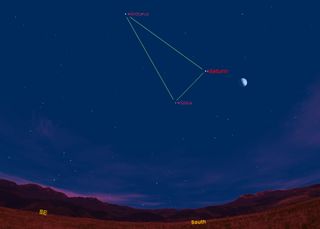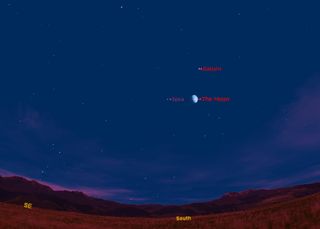
If you're outside soon after it gets sufficiently dark to see the stars this week, you may notice a large and slender isosceles triangle high in the southern night sky. The triangle appears tipped to the left, with the vertex poised high above the base; the triangle itself seems to be pointing toward the point directly overhead (called the zenith).
With the official start of summer in the Northern Hemisphere right around the corner, you might think that you are looking at the famous Summer Triangle. But no … that particular pattern of three bright stars is only now emerging into view, low in the east-northeast. [Sky map: Saturn Sky Triangle in June]
So what is this other eye-catching triangle of three bright stars?
Two stars … one Saturn
Actually ... only two of the three stars in the prominent isosceles triangle are stars. One of the "stars" is actually a planet! And as a result, this triangular pattern will appear to alter its shape in the weeks and months to come.
The planet in question is Saturn and it appears to glow a sedate yellow-white as one of the two “stars” in the base of the triangle. The other object is the bluish star Spica, in the constellation Virgo; Spica is on the left while Saturn is on the right. [Photos: The Rings and Moons of Saturn]
Saturn's rings, visible in any telescope magnifying at least 30-power, are currently tilted 7.3 degrees, the smallest for this year. In the course of the next six years the rings will gradually "open out," eventually reaching a maximum tilt toward Earth in October 2017.
Get the Space.com Newsletter
Breaking space news, the latest updates on rocket launches, skywatching events and more!
The third star in the triangle is the brilliant yellow-orange Arcturus in the constellation, Boötes. The triangle will remain in view until around 2 a.m. local time. By then, Saturn and Spica will be low on the west-southwest horizon and will soon set. Arcturus will remain in view, however, until the break of dawn.
A triangle in flux
As we noted earlier, thanks to the fact that a planet is part of this night sky triangle configuration, it's not going to remain this way for long.
On June 13, Saturn will seem to come to a halt against the background stars as it's retrograde or "backwards motion" comes to an end. Since late January, Saturn has been plodding slowly to the west, but after June 13 it will reverse course and start moving to the east toward Spica.
That means that the base of the triangle will be getting smaller and the triangle itself will appear to get narrower as the summer progresses.
By late September, Saturn and Spica will be getting too low in the western evening sky and too deeply immersed in the evening twilight to be seen. When they again become visible, it will be during early November, low in the east-southeast before sunrise.
But now, the Saturn-Spica-Arcturus pattern will no longer resemble a triangle, but rather more of a straight line.
That pretty much will be the case through next year, but two years from now, in the late spring and summer of 2013, our attractive isosceles triangle will return. Except Saturn and Spica will have exchanged their positions in the base of the triangle and the triangle itself will seem to be tipped to the right, not the left.

Moon joins sky triangle party
And if you can't get enough of triangles in our current evening sky, be sure to check out the scene soon after sunset on Friday (June 10), when the moon joins the show.
The apparent distances between objects in the night sky can be measured in terms of degrees. Your clenched fist held at arm's length, for example, could cover about 10 degrees of arc.
On Friday, Saturn will be high in the south-southwest at dusk and will appear to form a rather broad triangle with the waxing gibbous moon, about 10 degrees below it and Spica, about 15 degrees to Saturn's lower left.
Joe Rao serves as an instructor and guest lecturer at New York's Hayden Planetarium. He writes about astronomy for The New York Times and other publications, and he is also an on-camera meteorologist for News 12 Westchester, N.Y.
Join our Space Forums to keep talking space on the latest missions, night sky and more! And if you have a news tip, correction or comment, let us know at: community@space.com.

Joe Rao is Space.com's skywatching columnist, as well as a veteran meteorologist and eclipse chaser who also serves as an instructor and guest lecturer at New York's Hayden Planetarium. He writes about astronomy for Natural History magazine, the Farmers' Almanac and other publications. Joe is an 8-time Emmy-nominated meteorologist who served the Putnam Valley region of New York for over 21 years. You can find him on Twitter and YouTube tracking lunar and solar eclipses, meteor showers and more. To find out Joe's latest project, visit him on Twitter.
